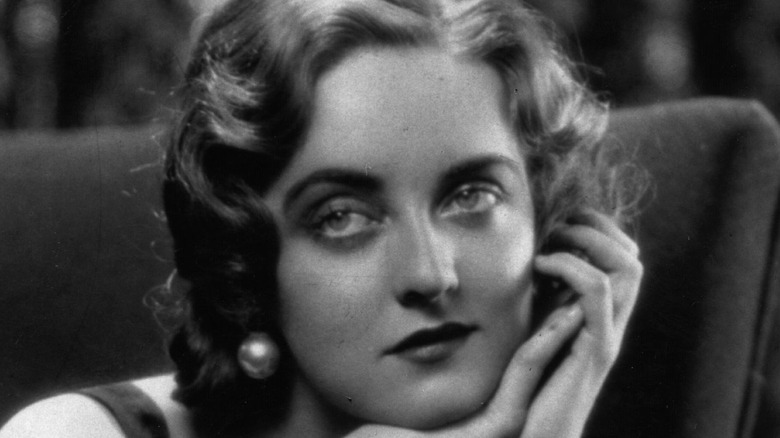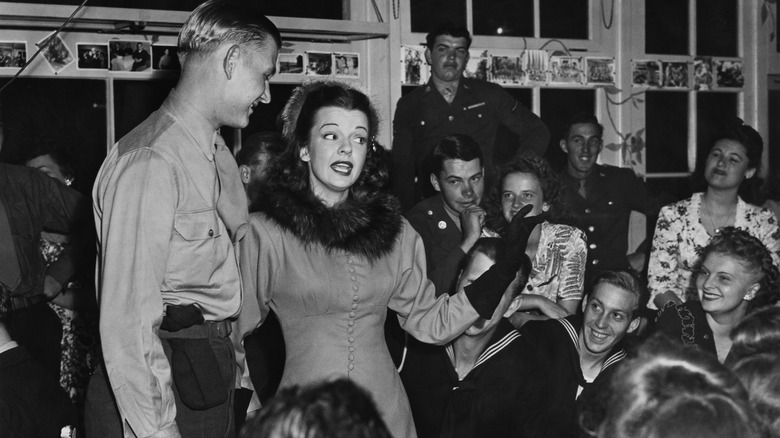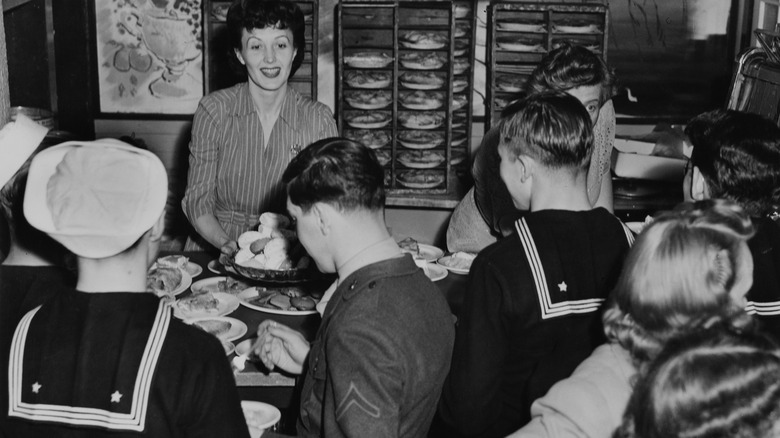How Did Bette Davis Help Bring About The Hollywood Canteen?
On October 3, 1942, the Hollywood Canteen officially opened its doors as an entertainment hall for servicemen and women. It was located at 1451 Cahuenga Boulevard in Hollywood, in a building that was formerly a stable, and those who were enlisted were able to enter the venue free of charge. According to Dusty Old Thing, the Hollywood Canteen was established to boost the morale of servicemen during World War II. Several celebrities — including Cary Grant, Shirley Temple, Duke Ellington, and Judy Garland, among others — volunteered their time and effort to provide entertainment and serve the guests.
It was actor John Garfield's idea to open the Hollywood Canteen in an effort to entertain the troops. Garfield himself wanted to serve in the Army, but he was prohibited from doing so because he had a heart problem (via Backlots). He shared the idea with his friend, actress Bette Davis, who then proposed it to the president of the Music Corporation of America, Jules Stein. The plan was soon set into motion, and plenty of volunteers helped in fixing an old stable. Garfield and Davis worked long hours, and the place was ready for the opening in less than a month. The project was a success, and per the National WW2 Museum, the first night of operations raised $10,000 from a door charge of $100 for non-service members. Davis recalled that so many people were present that she had to get into the venue through a window.
The success of the Hollywood Canteen
The Hollywood Canteen was successful in entertaining the troops, and entertainers were also satisfied knowing that they could bring a sense of happiness to the servicemen and women, even for a while. The location had a capacity of 2,000 people, and the Hollywood Canteen was packed each night, according to the National WW2 Museum. However, it didn't come without its share of problems, one of which was racial prejudice. As reported by Backlots, some white servicemen left the venue after seeing that there was no segregation. Bette Davis, who served as the president for the Hollywood Canteen, refused to perform in front of segregated audiences and said, "The blacks got the same bullets as the whites did, and should have the same treatment."
The Hollywood Canteen was also the inspiration for the Warner Bros. movie of the same name that was released in 1944. It was loosely based on Sgt. Carl Bell, who was the millionth service member who walked through the doors of the stable. He was escorted by actress Marlene Dietrich, was kissed by Betty Grable, and had a meeting with Lana Turner. Per the AFI Catalog, the film donated 40% of its sales to the Hollywood Canteen, and it was nominated for three categories at the Academy Awards.
The canteen closed its doors in 1945
Actor and comedian Bob Hope was a frequent entertainer at the Hollywood Canteen, and he served as the final performer when the venue officially closed its door on November 25, 1945, as reported by Cinema Scholars. At that time, more than 4 million service members had visited the Hollywood Canteen, and thousands of celebrities and entertainment industry employees had volunteered for the cause. In addition, 6 million slices of cake were served, 9 million cups of coffee were consumed, and 3 million packs of cigarettes were given to service members (the venue had a no-alcohol policy). After its closing, there was still $500,000 left from the canteen's operations, and the sum was donated to veteran relief operations (per National WW2 Museum).
At the time of the Hollywood Canteen's operations, Bette Davis was already a successful celebrity and had won a few acting awards and several nominations. Despite her acting accomplishments, however, she still considered the canteen as one of her most important contributions. "There are few accomplishments in my life that I am sincerely proud of. The Hollywood Canteen is one of them," Davis stated.


